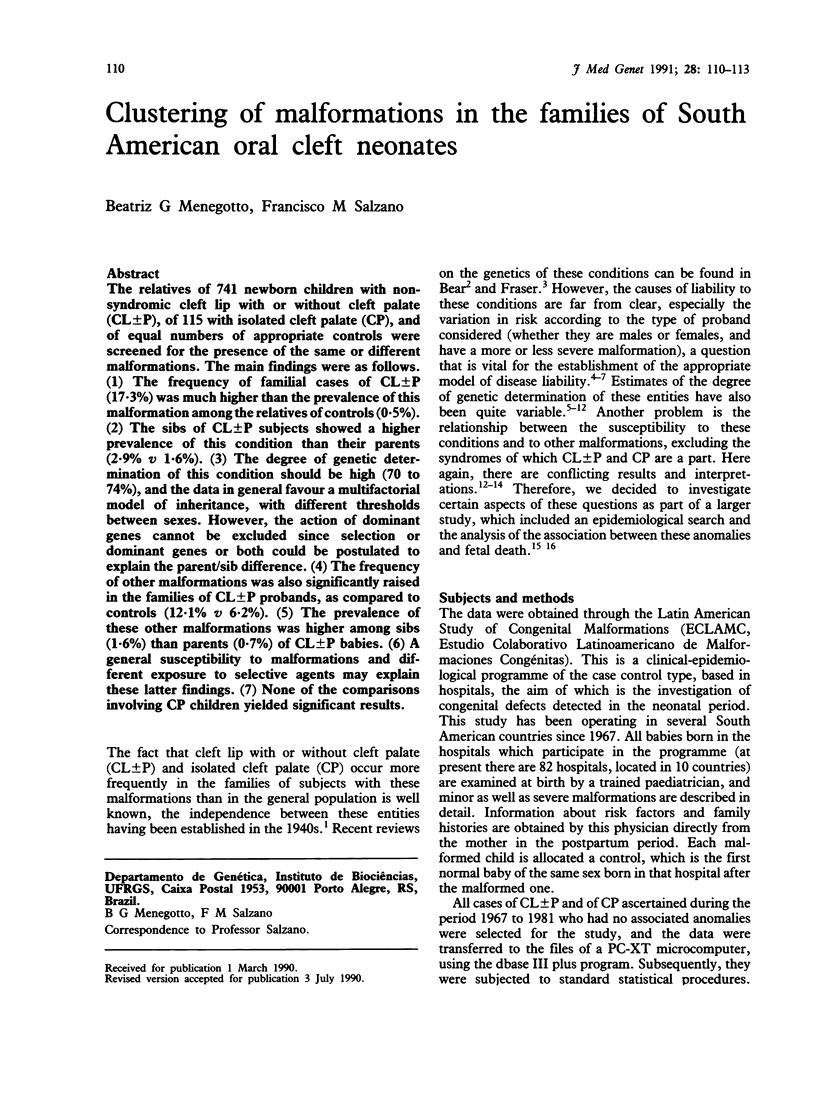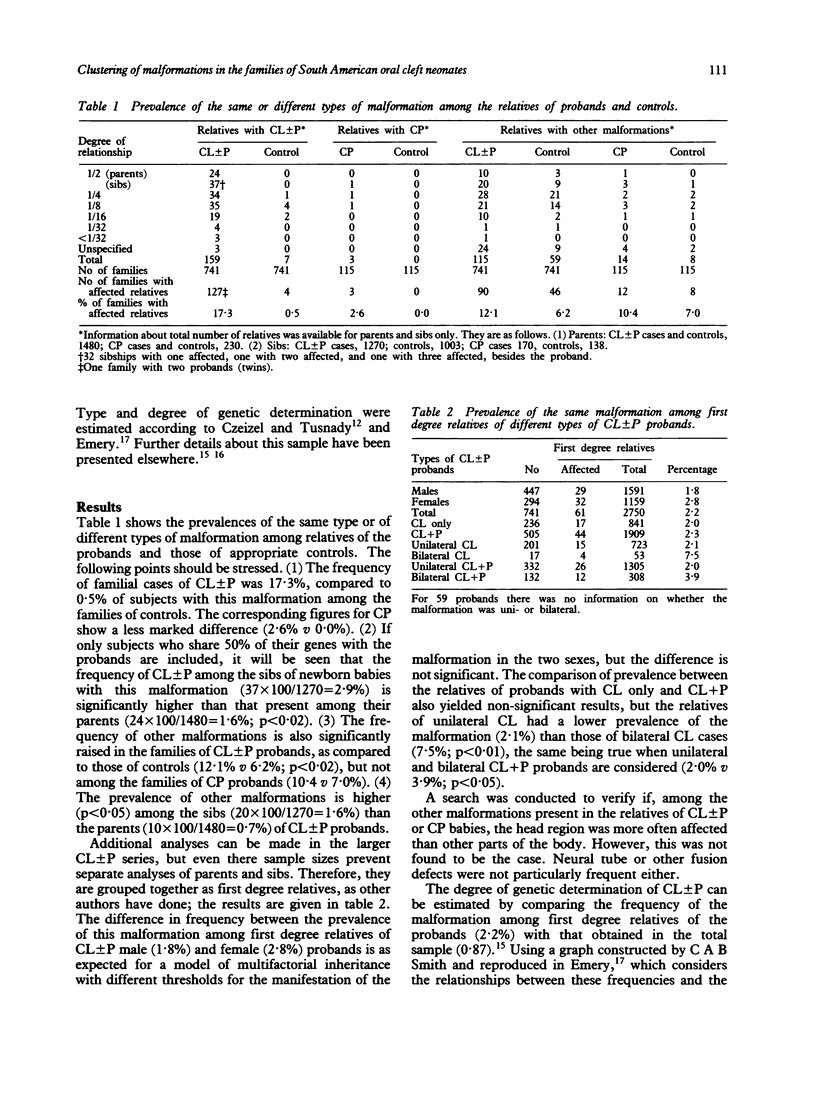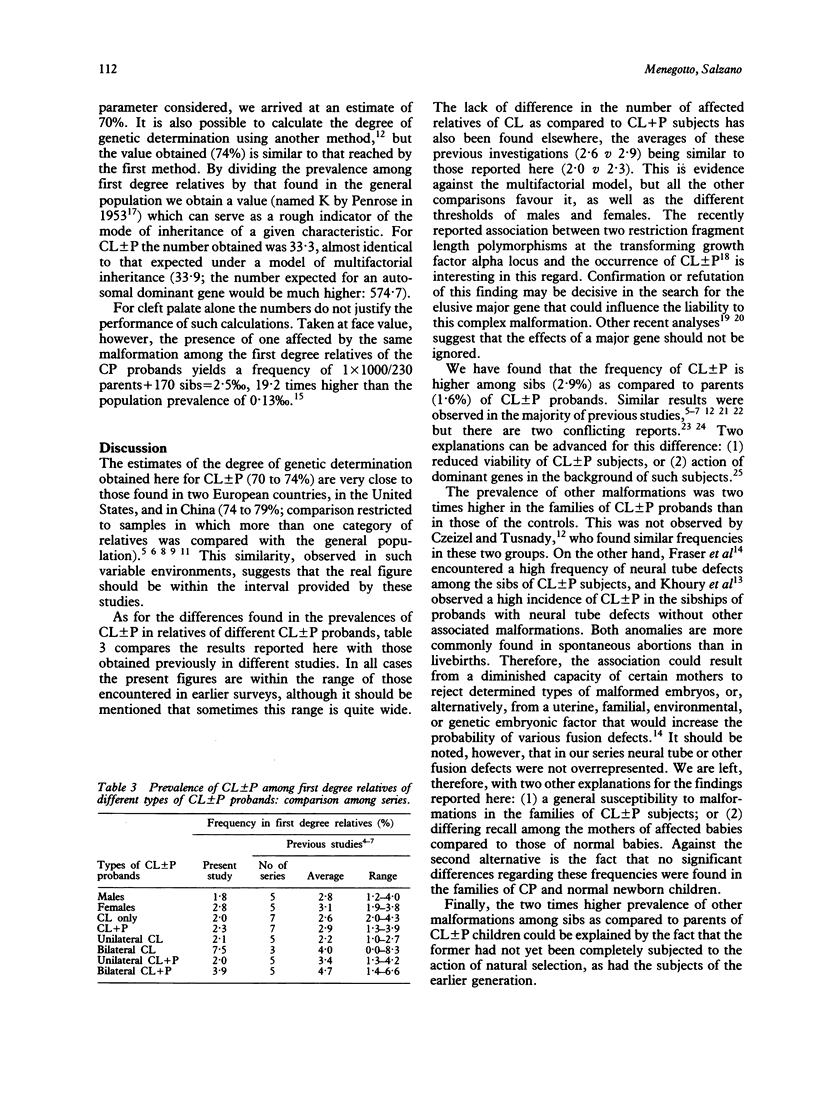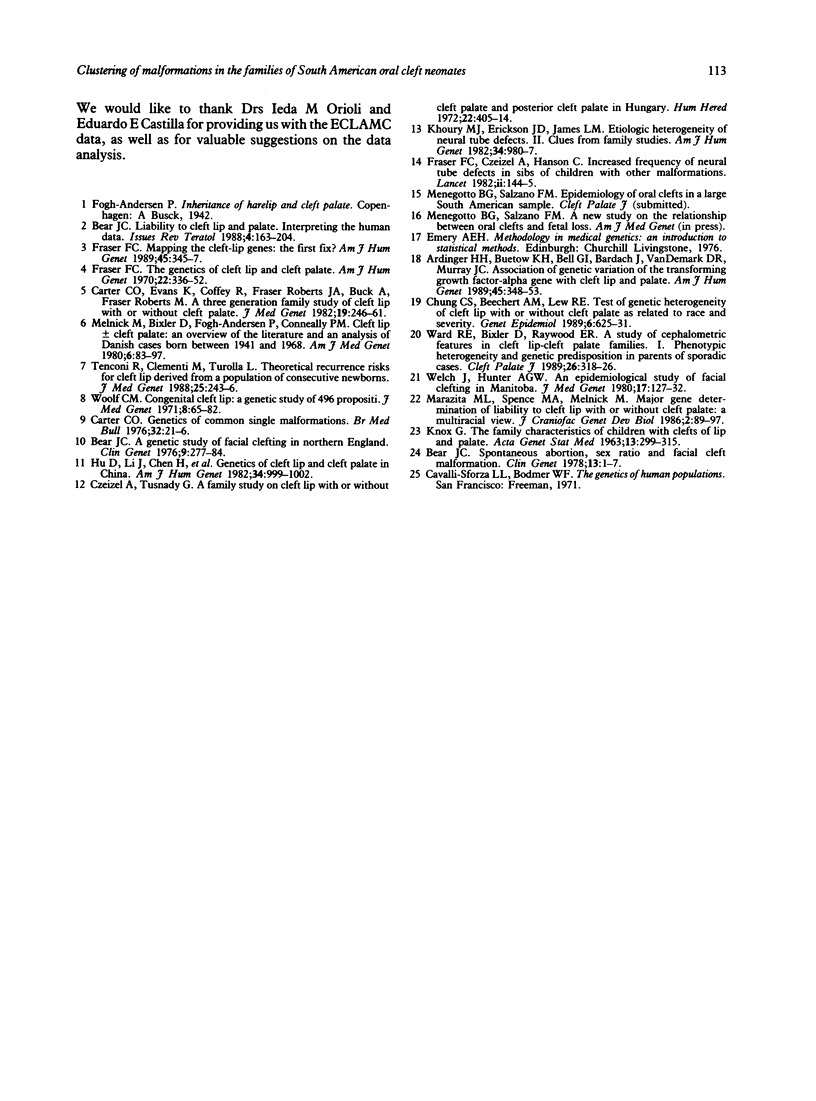Abstract
The relatives of 741 newborn children with non-syndromic cleft lip with or without cleft palate (CL +/- P), of 115 with isolated cleft palate (CP), and of equal numbers of appropriate controls were screened for the presence of the same or different malformations. The main findings were as follows. (1) The frequency of familial cases of CL +/- P (17.3%) was much higher than the prevalence of this malformation among the relatives of controls (0.5%). (2) The sibs of CL +/- P subjects showed a higher prevalence of this condition than their parents (2.9% v 1.6%). (3) The degree of genetic determination of this condition should be high (70 to 74%), and the data in general favour a multifactorial model of inheritance, with different thresholds between sexes. However, the action of dominant genes cannot be excluded since selection or dominant genes or both could be postulated to explain the parent/sib difference. (4) The frequency of other malformations was also significantly raised in the families of CL +/- P probands, as compared to controls (12.1% v 6.2%). (5) The prevalence of these other malformations was higher among sibs (1.6%) than parents (0.7%) of CL +/- P babies. (6) A general susceptibility to malformations and different exposure to selective agents may explain these latter findings. (7) None of the comparisons involving CP children yielded significant results.
Full text
PDF



Selected References
These references are in PubMed. This may not be the complete list of references from this article.
- Ardinger H. H., Buetow K. H., Bell G. I., Bardach J., VanDemark D. R., Murray J. C. Association of genetic variation of the transforming growth factor-alpha gene with cleft lip and palate. Am J Hum Genet. 1989 Sep;45(3):348–353. [PMC free article] [PubMed] [Google Scholar]
- Bear J. C. A genetic study of facial clefting in Northern England. Clin Genet. 1976 Mar;9(3):277–284. doi: 10.1111/j.1399-0004.1976.tb01575.x. [DOI] [PubMed] [Google Scholar]
- Bear J. C. Spontaneous abortion, sex ratio and facial cleft malformations. Clin Genet. 1978 Jan;13(1):1–7. doi: 10.1111/j.1399-0004.1978.tb04123.x. [DOI] [PubMed] [Google Scholar]
- Carter C. O., Evans K., Coffey R., Roberts J. A., Buck A., Roberts M. F. A three generation family study of cleft lip with or without cleft palate. J Med Genet. 1982 Aug;19(4):246–261. doi: 10.1136/jmg.19.4.246. [DOI] [PMC free article] [PubMed] [Google Scholar]
- Carter C. O. Genetics of common single malformations. Br Med Bull. 1976 Jan;32(1):21–26. doi: 10.1093/oxfordjournals.bmb.a071318. [DOI] [PubMed] [Google Scholar]
- Chung C. S., Beechert A. M., Lew R. E. Test of genetic heterogeneity of cleft lip with or without cleft palate as related to race and severity. Genet Epidemiol. 1989;6(5):625–631. doi: 10.1002/gepi.1370060507. [DOI] [PubMed] [Google Scholar]
- Czeizel A., Tusnady G. A family study on cleft lip with or without cleft palate and posterior cleft palate in Hungary. Hum Hered. 1972;22(5):405–416. doi: 10.1159/000152518. [DOI] [PubMed] [Google Scholar]
- Fraser F. C., Czeizel A., Hanson C. Increased frequency of neural tube defects in sibs of children with other malformations. Lancet. 1982 Jul 17;2(8290):144–145. doi: 10.1016/s0140-6736(82)91104-7. [DOI] [PubMed] [Google Scholar]
- Fraser F. C. Mapping the cleft-lip genes: the first fix? Am J Hum Genet. 1989 Sep;45(3):345–347. [PMC free article] [PubMed] [Google Scholar]
- Fraser F. C. The genetics of cleft lip and cleft palate. Am J Hum Genet. 1970 May;22(3):336–352. [PMC free article] [PubMed] [Google Scholar]
- Hu D. N., Li J. H., Chen H. Y., Chang H. S., Wu B. X., Lu Z. K., Wang D. Z., Liu X. G. Genetics of cleft lip and cleft palate in China. Am J Hum Genet. 1982 Nov;34(6):999–1002. [PMC free article] [PubMed] [Google Scholar]
- Khoury M. J., Erickson J. D., James L. M. Etiologic heterogeneity of neural tube defects. II. Clues from family studies. Am J Hum Genet. 1982 Nov;34(6):980–987. [PMC free article] [PubMed] [Google Scholar]
- Marazita M. L., Spence M. A., Melnick M. Major gene determination of liability to cleft lip with or without cleft palate: a multiracial view. J Craniofac Genet Dev Biol Suppl. 1986;2:89–97. [PubMed] [Google Scholar]
- Melnick M., Bixler D., Fogh-Andersen P., Conneally P. M. Cleft lip+/-cleft palate: an overview of the literature and an analysis of Danish cases born between 1941 and 1968. Am J Med Genet. 1980;6(1):83–97. doi: 10.1002/ajmg.1320060108. [DOI] [PubMed] [Google Scholar]
- Tenconi R., Clementi M., Turolla L. Theoretical recurrence risks for cleft lip derived from a population of consecutive newborns. J Med Genet. 1988 Apr;25(4):243–246. doi: 10.1136/jmg.25.4.243. [DOI] [PMC free article] [PubMed] [Google Scholar]
- Ward R. E., Bixler D., Raywood E. R. A study of cephalometric features in cleft lip-cleft palate families. I: Phenotypic heterogeneity and genetic predisposition in parents of sporadic cases. Cleft Palate J. 1989 Oct;26(4):318–326. [PubMed] [Google Scholar]
- Welch J., Hunter A. G. An epidemiological study of facial clefting in Manitoba. J Med Genet. 1980 Apr;17(2):127–132. doi: 10.1136/jmg.17.2.127. [DOI] [PMC free article] [PubMed] [Google Scholar]
- Woolf C. M. Congenital cleft lip. A genetic study of 496 propositi. J Med Genet. 1971 Mar;8(1):65–83. doi: 10.1136/jmg.8.1.65. [DOI] [PMC free article] [PubMed] [Google Scholar]


